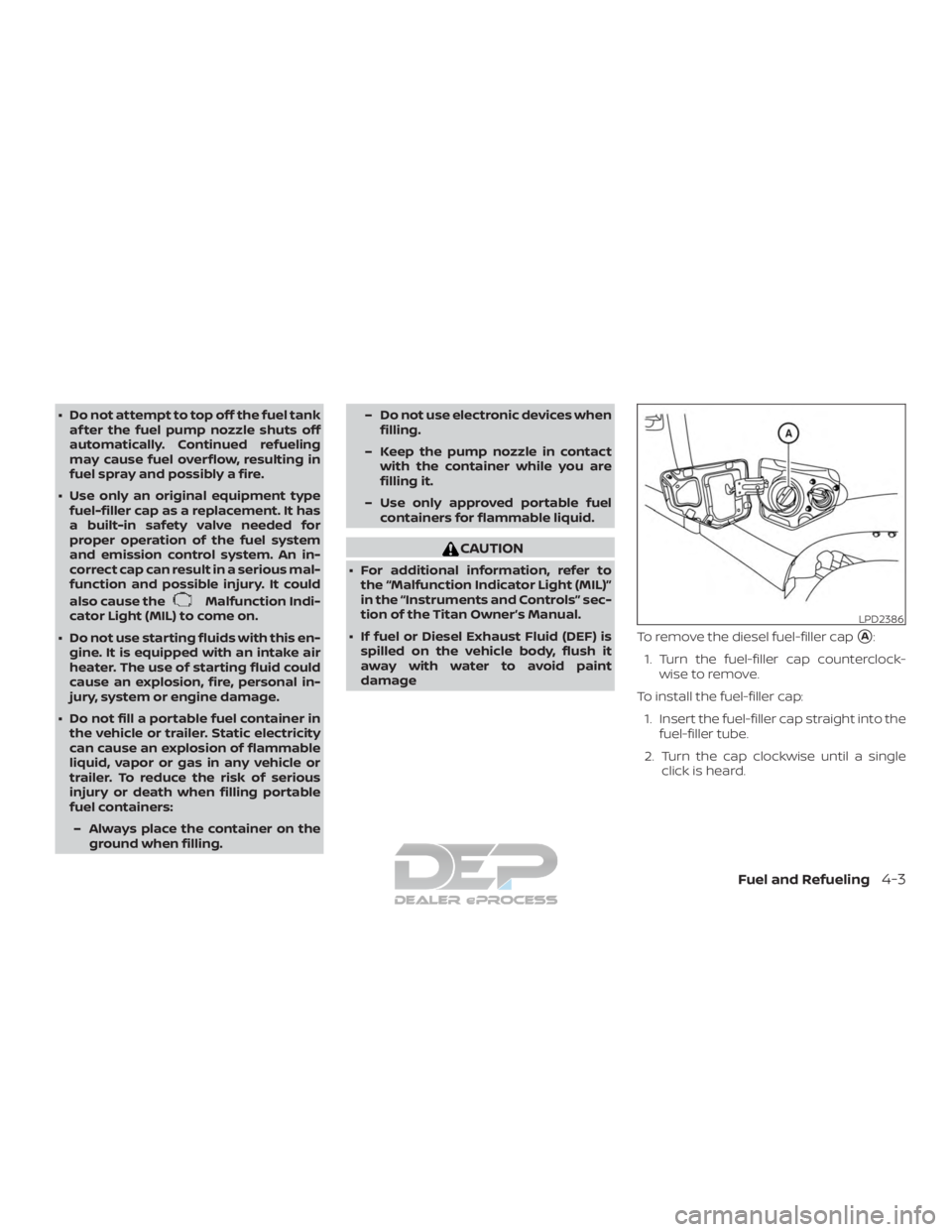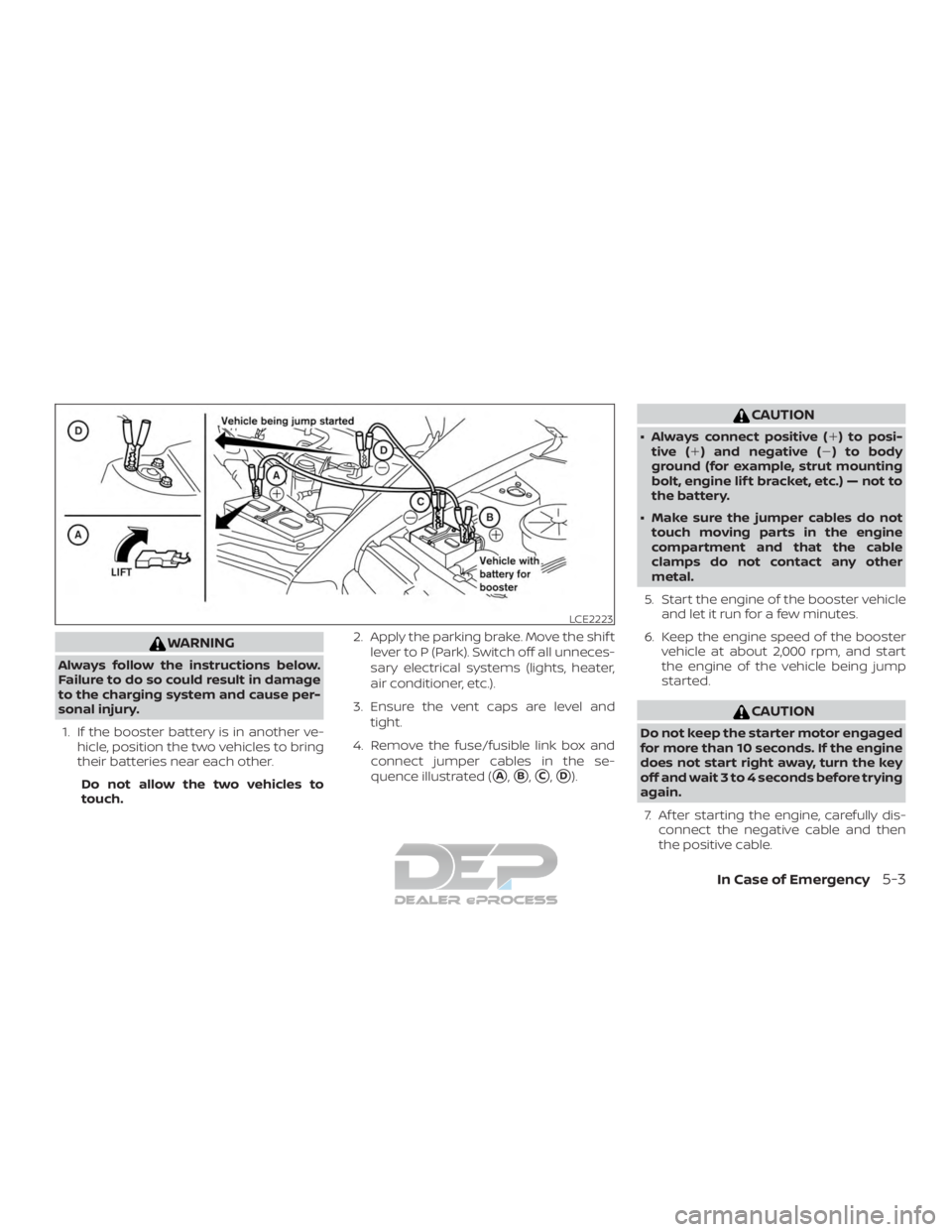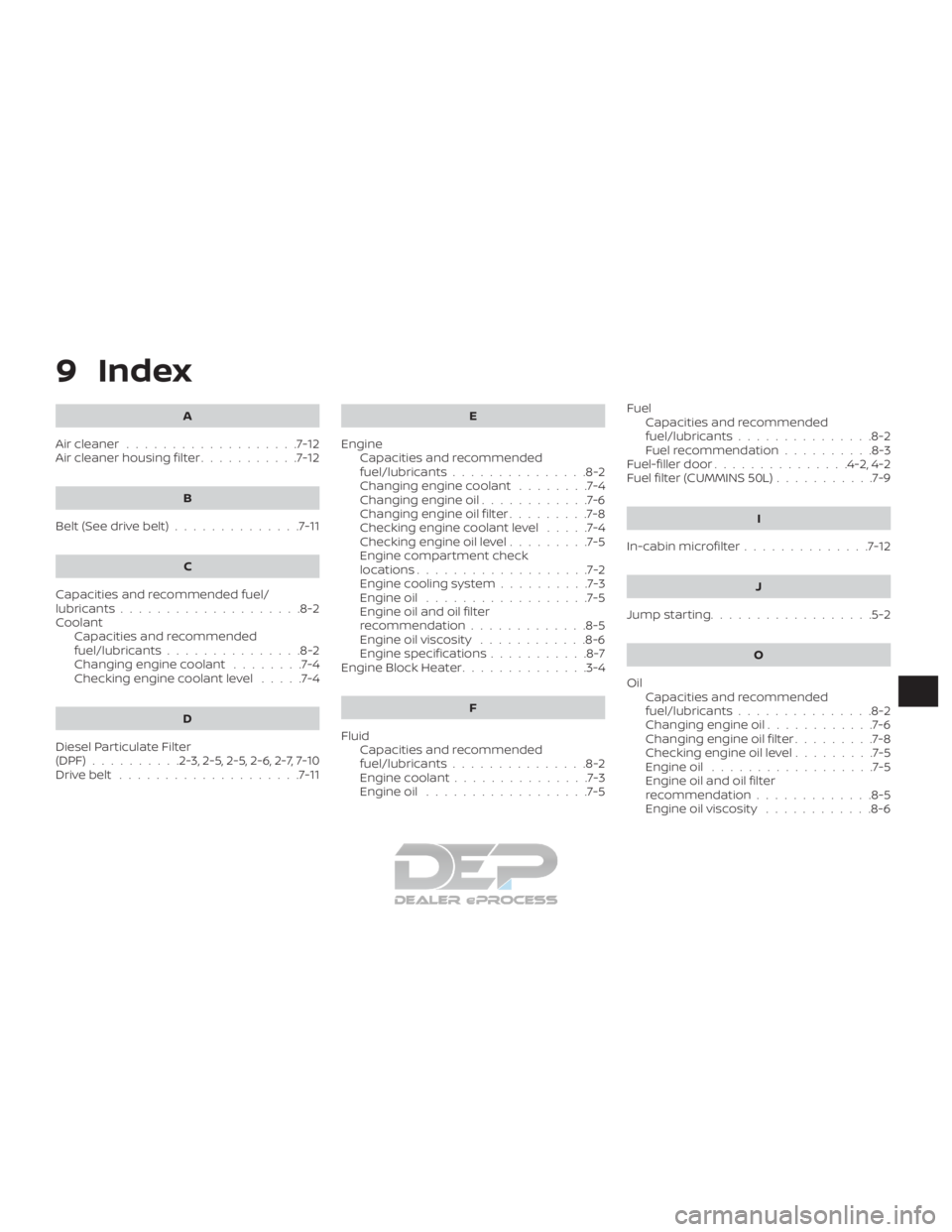Page 642 of 682

∙ Do not attempt to top off the fuel tankaf ter the fuel pump nozzle shuts off
automatically. Continued refueling
may cause fuel overflow, resulting in
fuel spray and possibly a fire.
∙ Use only an original equipment type fuel-filler cap as a replacement. It has
a built-in safety valve needed for
proper operation of the fuel system
and emission control system. An in-
correct cap can result in a serious mal-
function and possible injury. It could
also cause the
Malfunction Indi-
cator Light (MIL) to come on.
∙ Do not use starting fluids with this en- gine. It is equipped with an intake air
heater. The use of starting fluid could
cause an explosion, fire, personal in-
jury, system or engine damage.
∙ Do not fill a portable fuel container in the vehicle or trailer. Static electricity
can cause an explosion of flammable
liquid, vapor or gas in any vehicle or
trailer. To reduce the risk of serious
injury or death when filling portable
fuel containers:
– Always place the container on the ground when filling. – Do not use electronic devices when
filling.
– Keep the pump nozzle in contact with the container while you are
filling it.
– Use only approved portable fuel containers for flammable liquid.
CAUTION
∙ For additional information, refer tothe “Malfunction Indicator Light (MIL)”
in the “Instruments and Controls” sec-
tion of the Titan Owner’s Manual.
∙ If fuel or Diesel Exhaust Fluid (DEF) is spilled on the vehicle body, flush it
away with water to avoid paint
damage To remove the diesel fuel-filler cap
�A:
1. Turn the fuel-filler cap counterclock- wise to remove.
To install the fuel-filler cap: 1. Insert the fuel-filler cap straight into the fuel-filler tube.
2. Turn the cap clockwise until a single click is heard.
LPD2386
Fuel and Refueling4-3
Page 648 of 682

WARNING
Always follow the instructions below.
Failure to do so could result in damage
to the charging system and cause per-
sonal injury.1. If the booster battery is in another ve- hicle, position the two vehicles to bring
their batteries near each other.
Do not allow the two vehicles to
touch. 2. Apply the parking brake. Move the shif t
lever to P (Park). Switch off all unneces-
sary electrical systems (lights, heater,
air conditioner, etc.).
3. Ensure the vent caps are level and tight.
4. Remove the fuse/fusible link box and connect jumper cables in the se-
quence illustrated (
�A,�B,�C,�D).
CAUTION
∙ Always connect positive (�) to posi-tive ( �) and negative (�) to body
ground (for example, strut mounting
bolt, engine lif t bracket, etc.) — not to
the battery.
∙ Make sure the jumper cables do not touch moving parts in the engine
compartment and that the cable
clamps do not contact any other
metal.
5. Start the engine of the booster vehicle and let it run for a few minutes.
6. Keep the engine speed of the booster vehicle at about 2,000 rpm, and start
the engine of the vehicle being jump
started.
CAUTION
Do not keep the starter motor engaged
for more than 10 seconds. If the engine
does not start right away, turn the key
off and wait 3 to 4 seconds before trying
again.
7. Af ter starting the engine, carefully dis- connect the negative cable and then
the positive cable.
LCE2223
In Case of Emergency5-3
Page 657 of 682

CHECKING ENGINE COOLANT
LEVEL
Check the coolant levelin the reservoir
when the engine is cold. If the coolant
level is below the MIN level
�B, add coolant
to the MAX level
�A. If the reservoir is empty,
check the coolant level in the radiator
when the engine is cold. If there is insuffi-
cient coolant in the radiator, fill the radiator
with coolant up to the filler opening and
also add it to the reservoir up to the MAX
level
�A.
This vehicle contains Genuine NISSAN Long
Life Antifreeze/Coolant (blue). The life ex- pectancy of the factory-fill coolant is
45,000 miles (78,000 km) or 3 years. Mixing
any other type of coolant or the use of
non-distilled water may reduce the life ex-
pectancy of the factory-fill coolant. For ad-
ditional information, refer to the Titan Own-
er’s Manual.
CAUTION
Never use any cooling system additives
such as radiator sealer. Additives may
clog the cooling system and cause
damage to the engine, transmission
and/or cooling system.
If the cooling system frequently requires
coolant, have it checked. It is recom-
mended that you visit a NISSAN dealer
for this service.
For additional information on the location
of the engine coolant reservoir, refer to “En-
gine compartment check locations” in this
section.
CHANGING ENGINE COOLANT
A NISSAN dealer can change the engine
coolant. The service procedure can be
found in the NISSAN Service Manual. Improper servicing can result in reduced
heater performance and engine over-
heating.
WARNING
∙ To avoid the danger of being scalded,
never change the coolant when the
engine is hot.
∙ Never remove the radiator or engine coolant reservoir cap when the en-
gine is hot. Serious burns could be
caused by high pressure fluid escap-
ing from the radiator.
∙ Avoid direct skin contact with used coolant. If skin contact is made, wash
thoroughly with soap or hand cleaner
as soon as possible.
∙ Keep coolant out of the reach of chil- dren and pets.
Engine coolant must be disposed of prop-
erly. Check your local regulations.
LDI2871
7-4Do-it-yourself
Page 674 of 682

9 Index
A
Air cleaner ...................7-12
Air cleaner housing filter ...........7-12
B
Belt(Seedrivebelt)..............7-11
C
Capacities and recommended fuel/
lubricants....................8-2
Coolant Capacities and recommended
fuel/lubricants...............8-2
Changing engine coolant ........7-4
Checking engine coolant level .....7-4
D
Diesel Particulate Filter
(DPF) ..........2-3,2-5,2-5,2-6,2-7,7-10
Drivebelt ....................7-11 E
Engine Capacities and recommended
fuel/lubricants...............8-2
Changing engine coolant ........7-4
Changing engine oil ............7-6
Changing engine oil filter .........7-8
Checking engine coolant level .....7-4
Checking engine oil level .........7-5
Engine compartment check
locations...................7-2
Engine cooling system ..........7-3
Engine oil ..................7-5
Engine oil and oil filter
recommendation .............8-5
Engine oil viscosity ............8-6
Engine specifications ...........8-7
Engine Block Heater ..............3-4
F
Fluid Capacities and recommended
fuel/lubricants...............8-2
Engine coolant ...............7-3
Engine oil ..................7-5 Fuel
Capacities and recommended
fuel/lubricants...............8-2
Fuel recommendation ..........8-3
Fuel-filler door ...............4-2,4-2
Fuel filter (CUMMINS 50L) ...........7-9
I
In-cabinmicrofilter..............7-12
J
Jumpstarting..................5-2
O
Oil Capacities and recommended
fuel/lubricants...............8-2
Changing engine oil ............7-6
Changing engine oil filter .........7-8
Checking engine oil level .........7-5
Engine oil ..................7-5
Engine oil and oil filter
recommendation .............8-5
Engine oil viscosity ............8-6